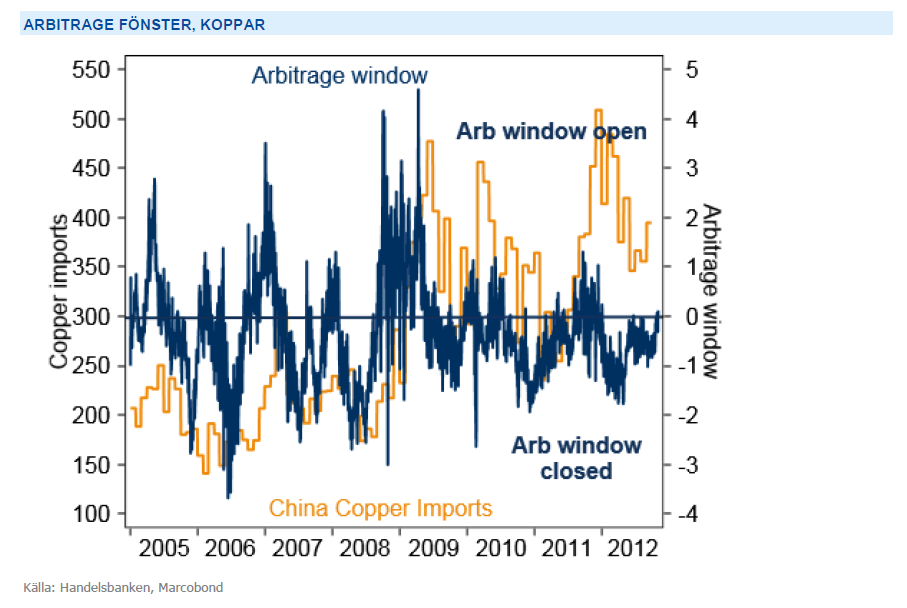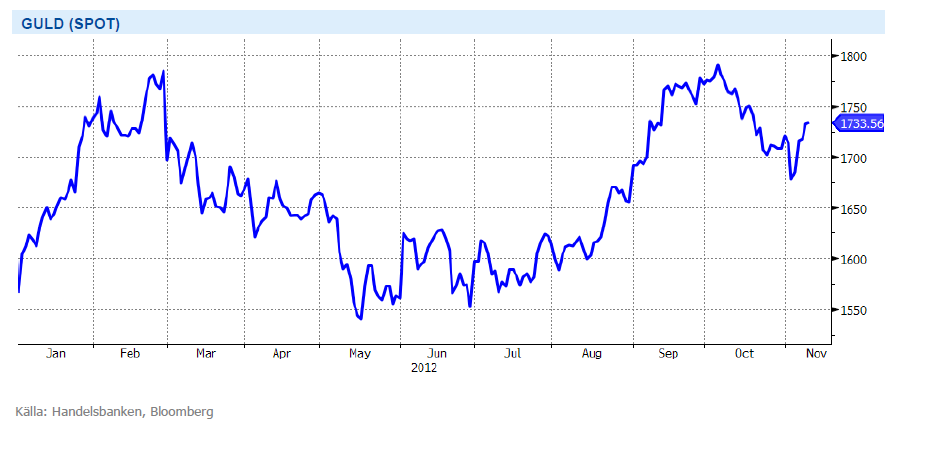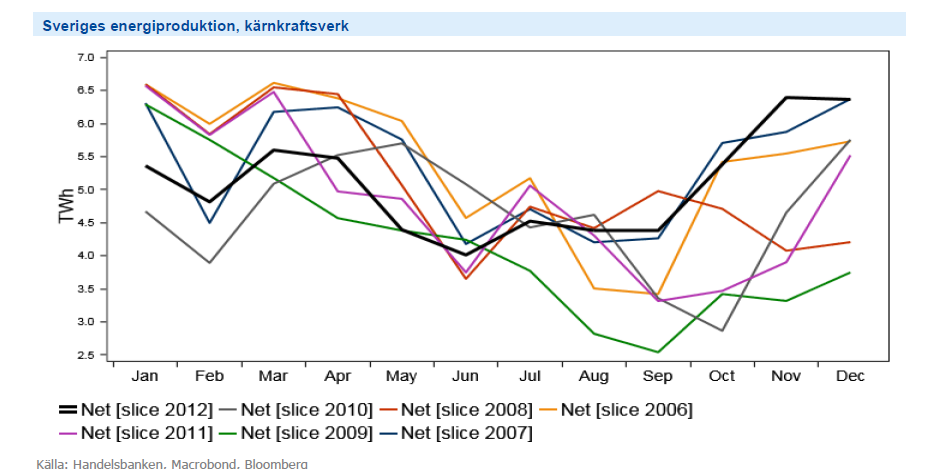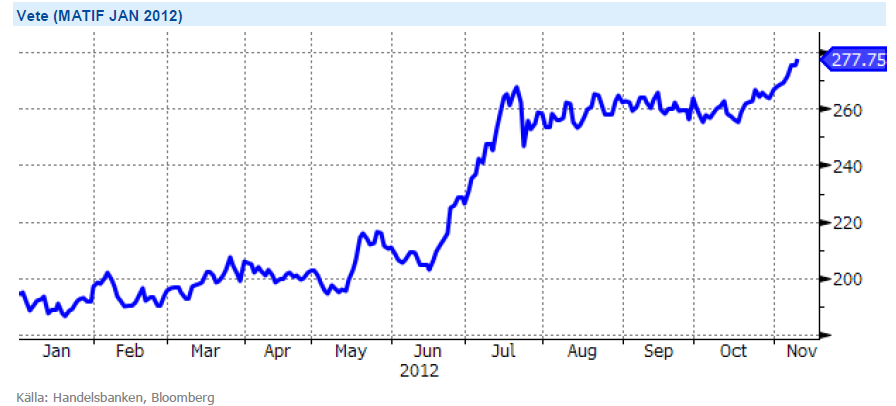Analys
SHB Råvarubrevet 9 november 2012
 Iskall konjunkturell vinter i Sverige – men gröna bambuskott i Kina
Iskall konjunkturell vinter i Sverige – men gröna bambuskott i Kina
Risksentimentet har haft det kämpigt de senaste veckorna, trots gröna skott i Kina och USA. Marknaden har åter tvingats fokusera på Grekland och Spanien, mestadels tack vare sedvanligt politiskt käbbel. Samtidigt har oron kring det finanspolitiska stupet kommit som ett brev på posten efter USA:s presidentval.
Förra året enades USA:s politiker bland annat om att tillfälligt förlänga de skattelättnader som infördes av Bush 2001-03. Utöver dessa kommer också ökat skattetryck från Obamas sjukvårdspaket. Sammantaget skulle oförändrad finanspolitik motsvara skattehöjningar och utgiftsminskningar på nära 4 % av BNP nästa år. Med dagens tillväxttakt på drygt 2 % skulle ett fall utför budgetstupet föra USA in i en ny recession. Vi räknar emellertid med att det politiska systemet lyckas komma överrens, måhända under årets sista skälvande timmar. På fredagsmorgonen kom bra oktoberdata från Kina som styrker vår positiva syn på basmetaller och som bekräftar att vändningen i den kinesiska konjunkturen i september fortsätter. Grekkaos och fiscal cliff spred dock smolk i glädjebägaren. Samtidigt har det kommit mycket dålig data från Sverige men den ska man inte tolka som negativt för råvarorna som handlas på världsmarknaden.
Basmetallerna
Kinas återhämtning finns framför oss
Basmetallerna startade veckan med stigande priser men vände ned igen då dollar stärktes efter valet i USA. Från måndagens öppning stänger kopparn på -1,1 %, aluminium är ned med 0,6 % medan nickel är princip oförändrad. Imorse fick vi dock positiv data från Kina där industriproduktionen kom in på 9,6 % (väntat 9,4%) i oktober jämfört med 9,2% i september och investeringar (FAI) YTD kom in på 20,7 % (väntat 20,6%) mot 20,5% i september.
Kopparlagren i Kina (både bonded och SHFE) är på rekordnivåer och trots att Kina importerat mycket de senaste månaderna har lagren utanför Kina inte minskat vilket vittnar om en fortsatt svag konsumtion globalt (ex Kina). Totala lager ligger nu på ca 1.2 miljoner ton (+0.3 miljoner ton sen i somras) men vi förväntar oss att överskottet reduceras något mot slutet av året/inledningen av 2013 i takt med att kinesiska verk nu betat av sina lager och börjar bygga upp nya. Kopparbalansen ser vidare ut att bli negativ under 2013 för första gången på tre år. Arbitragefönstret mellan Shanghai och LME åter öppet (se blå graf nedan som nu är positiv) vilket bör ge stöd åt Kinesisk import och kopparpriset. Vi behåller vår positiva vy för basmetaller.
Under oktober har basmetallerna haft ett kraftigt ras, efter den kraftiga uppgången i september. Finansmarknaden hade handlat in för mycket på för kort tid. Däremot ser Kinadata allt bättre ut nu. Vi tror på: Vi tror på: BASMET H
Ädelmetaller
Fiscal cliff stärker guldet
Ädelmetallerna har hämtat sig från förra veckans fall, och Handelsbankens ädelmetallindex har stigit med nästan 3 % sedan fredagens stängning. Med en omvald Barack Obama i vita huset är diskussionen kring fiscal cliff (finanspolitiska stupet) åter på agendan vilket har fått guldet att stiga i värde. Fiscal cliff tillsammans med förnyad oro kring eurokrisen ökar investerares vilja att fly till guldet. Guldet handlas nu på 1733 USD/uns, vilket är 3,3 % högre än veckans öppning.
I och med att Obama blev omvald så är chanserna för fortsatt mjuk penningpolitik mycket större än om Romney blivit vald till USA:s president vilket talar till guldets fördel. Vi behåller vår positiva vy för hela sektorn.
Rapporterna kring strejkerna i de sydafrikanska gruvorna har tystnat, vilket tyder på att situationen återgått till det normala – dock med betydligt färre arbetare i gruvorna.
Vi är fortsatt positiva till ädelmetaller med den främsta anledningen att vi tror på fortsatt mjuk penningpolitik från FED och att central bankernas stimulanser forstätter att ge stöd. Vi tror på: ADELMET H
Energi
Fortsatt bensinbrist i USA
Omvalet av Barack Obama som USA:s president har inte haft något tydlig inverkan på oljepriset. Däremot är det fortfarande bensinbrist i spåren efter stormen Sandy, endast en fjärdedel av bensinstationerna i New York City, Long Island och New Jersey är i drift. Nu sätts åtgärder in för att försöka lindra problemet. Det beredskapslager som inrättades 2000 öppnas nu energidepartementet. Försvaret har fått i uppgift att köpa in och distribuera inte mindre än 380 000 fat blyfri bensin och 317 000 fat diesel till de berörda områdena. Brent-oljan handlas i skrivande stund på 107 USD/fat vilket är 1,15 % högre än måndagens öppning, i onsdag handlas dock oljan upp på dryga 111 USD/fat.
Marginellt ned på elmarknaden under veckan och även om vi inte förväntar oss några större rörelser är sentimentet fortsatt svagt. Såväl kol som utsläppsrätter handlas oförändrat och ser vi till vädret förväntas temperaturen ligga en ca 3 grader över normalt de kommande tio dagarna medan nederbördsmängderna beräknas till ca 7 TWh vilket är normalt denna tid på året. En del av den förväntade nederbörden uteblev vilket innebär att energibalansen minskar till ca 8.5 TWh. Svensk kärnkraft går mot bästa novemberproduktionen sedan Barsebäck stängdes (maj 2005) och december kan bli ännu bättre då vår tionde och minsta reaktor, Oskarshamn 1, fortfarande står stilla. Övriga 9 reaktorer är nu igång efter årets revision (underhåll) och då är risken mycket liten att de inte levererar i vinter. Notera den bedrövliga vintern 09/10 i bilden nedan.
Oljan har sett allt svagare ut och vi fortsätter tycka att underliggande fundamenta är väl balanserad. Vi ser även att förutsättningarna för fortsatt lågt elpris kvarstår. Vi håller en neutral syn på energisektorn.
Livsmedel
Global veteproduktion väntas justeras ned
Terminspriser på vete har gått upp sedan förra veckan i både Chicago och Paris. Det amerikanska höstvetet lider fortfarande av torrt och varmt väder och någon klar bättring ser inte ut att vara i sikte. Skicket på grödan bedöms vara rekorddåligt och ytterligare försämring är nog att vänta. I Argentina har det blivit lite torrare, vilket gynnar pågående skörd. Lite regn har fallit i de östra delarna av Australien, generellt sett är det dock väldigt torrt. Den nederbörd som fallit lär nog inte ha någon större effekt, men bromsar en fortsatt nedgång. I dagens WASDE-rapport från USDA bör produktionssiffrorna för den australiensiska skörden justeras ned från föregående rapports 23 miljoner ton, 20 miljoner ton eller strax därunder är nog mer rimligt.
I EU är det fortfarande blött i en del områden och tiden för sådd löper snart ut. I Frankrike rapporterades tidigare i veckan om att sådden var avklarad endast till 64 procent, att jämföra med 88 procent vid samma tid förra året. Än värre är det i Storbritannien där det nu talas om att höstsådden kanske inte når mycket mer än 60 procent av tidigare planerad areal. I dagens WASDE-rapport väntas inga större förändringar för det amerikanska vetet. För den globala produktionen väntas däremot nedjusteringar för främst Australien och Argentina – förmodligen dock inte till fullt så låga nivåer som de lokala analytikernas utan kvar något över likt föregående månad. Med försämrade förutsättningar för nästa års skörd bör en eventuell nedsida vara väldigt begränsad. En bra start på grödan är givetvis att föredra men mycket kan hända tills nästa års skörd och vi har sett förr att de höstsådda grödorna återhämtat sig väl efter vintern.
Vi ser soja, majs och vete som klara säljcase där vi väntar oss prisfall före jul men senast till påsk. Vi tror på: LIVSMEDEL S H
Handelsbankens Råvaruindex
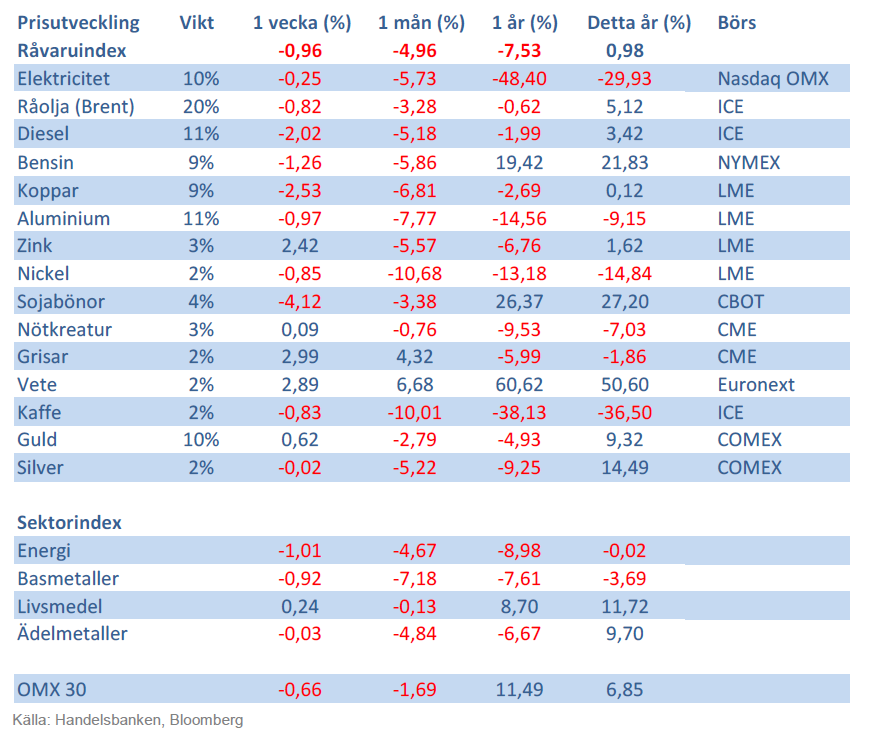
Handelsbankens råvaruindex består av de underliggande indexen för respektive råvara. Vikterna är bestämda till hälften från värdet av global produktion och till hälften från likviditeten i terminskontrakten.
[box]SHB Råvarubrevet är producerat av Handelsbanken och publiceras i samarbete och med tillstånd på Råvarumarknaden.se[/box]
Ansvarsbegränsning
Detta material är producerat av Svenska Handelsbanken AB (publ) i fortsättningen kallad Handelsbanken. De som arbetar med innehållet är inte analytiker och materialet är inte oberoende investeringsanalys. Innehållet är uteslutande avsett för kunder i Sverige. Syftet är att ge en allmän information till Handelsbankens kunder och utgör inte ett personligt investeringsråd eller en personlig rekommendation. Informationen ska inte ensamt utgöra underlag för investeringsbeslut. Kunder bör inhämta råd från sina rådgivare och basera sina investeringsbeslut utifrån egen erfarenhet.
Informationen i materialet kan ändras och också avvika från de åsikter som uttrycks i oberoende investeringsanalyser från Handelsbanken. Informationen grundar sig på allmänt tillgänglig information och är hämtad från källor som bedöms som tillförlitliga, men riktigheten kan inte garanteras och informationen kan vara ofullständig eller nedkortad. Ingen del av förslaget får reproduceras eller distribueras till någon annan person utan att Handelsbanken dessförinnan lämnat sitt skriftliga medgivande. Handelsbanken ansvarar inte för att materialet används på ett sätt som strider mot förbudet mot vidarebefordran eller offentliggörs i strid med bankens regler.
Analys
Brent crude ticks higher on tension, but market structure stays soft

Brent crude has climbed roughly USD 1.5-2 per barrel since Friday, yet falling USD 0.3 per barrel this mornig and currently trading near USD 67.25/bbl after yesterday’s climb. While the rally reflects short-term geopolitical tension, price action has been choppy, and crude remains locked in a broader range – caught between supply-side pressure and spot resilience.

Prices have been supported by renewed Ukrainian drone strikes targeting Russian infrastructure. Over the weekend, falling debris triggered a fire at the 20mtpa Kirishi refinery, following last week’s attack on the key Primorsk terminal.
Argus estimates that these attacks have halted ish 300 kbl/d of Russian refining capacity in August and September. While the market impact is limited for now, the action signals Kyiv’s growing willingness to disrupt oil flows – supporting a soft geopolitical floor under prices.
The political environment is shifting: the EU is reportedly considering sanctions on Indian and Chinese firms facilitating Russian crude flows, while the U.S. has so far held back – despite Bessent warning that any action from Washington depends on broader European participation. Senator Graham has also publicly criticized NATO members like Slovakia and Hungary for continuing Russian oil imports.
It’s worth noting that China and India remain the two largest buyers of Russian barrels since the invasion of Ukraine. While New Delhi has been hit with 50% secondary tariffs, Beijing has been spared so far.
Still, the broader supply/demand balance leans bearish. Futures markets reflect this: Brent’s prompt spread (gauge of near-term tightness) has narrowed to the current USD 0.42/bl, down from USD 0.96/bl two months ago, pointing to weakening backwardation.
This aligns with expectations for a record surplus in 2026, largely driven by the faster-than-anticipated return of OPEC+ barrels to market. OPEC+ is gathering in Vienna this week to begin revising member production capacity estimates – setting the stage for new output baselines from 2027. The group aims to agree on how to define “maximum sustainable capacity,” with a proposal expected by year-end.
While the IEA pegs OPEC+ capacity at 47.9 million barrels per day, actual output in August was only 42.4 million barrels per day. Disagreements over data and quota fairness (especially from Iraq and Nigeria) have already delayed this process. Angola even quit the group last year after being assigned a lower target than expected. It also remains unclear whether Russia and Iraq can regain earlier output levels due to infrastructure constraints.
Also, macro remains another key driver this week. A 25bp Fed rate cut is widely expected tomorrow (Wednesday), and commodities in general could benefit a potential cut.
Summing up: Brent crude continues to drift sideways, finding near-term support from geopolitics and refining strength. But with surplus building and market structure softening, the upside may remain capped.
Analys
Volatile but going nowhere. Brent crude circles USD 66 as market weighs surplus vs risk

Brent crude is essentially flat on the week, but after a volatile ride. Prices started Monday near USD 65.5/bl, climbed steadily to a mid-week high of USD 67.8/bl on Wednesday evening, before falling sharply – losing about USD 2/bl during Thursday’s session.

Brent is currently trading around USD 65.8/bl, right back where it began. The volatility reflects the market’s ongoing struggle to balance growing surplus risks against persistent geopolitical uncertainty and resilient refined product margins. Thursday’s slide snapped a three-day rally and came largely in response to a string of bearish signals, most notably from the IEA’s updated short-term outlook.
The IEA now projects record global oversupply in 2026, reinforcing concerns flagged earlier by the U.S. EIA, which already sees inventories building this quarter. The forecast comes just days after OPEC+ confirmed it will continue returning idle barrels to the market in October – albeit at a slower pace of +137,000 bl/d. While modest, the move underscores a steady push to reclaim market share and adds to supply-side pressure into year-end.
Thursday’s price drop also followed geopolitical incidences: Israeli airstrikes reportedly targeted Hamas leadership in Doha, while Russian drones crossed into Polish airspace – events that initially sent crude higher as traders covered short positions.
Yet, sentiment remains broadly cautious. Strong refining margins and low inventories at key pricing hubs like Europe continue to support the downside. Chinese stockpiling of discounted Russian barrels and tightness in refined product markets – especially diesel – are also lending support.
On the demand side, the IEA revised up its 2025 global demand growth forecast by 60,000 bl/d to 740,000 bl/d YoY, while leaving 2026 unchanged at 698,000 bl/d. Interestingly, the agency also signaled that its next long-term report could show global oil demand rising through 2050.
Meanwhile, OPEC offered a contrasting view in its latest Monthly Oil Market Report, maintaining expectations for a supply deficit both this year and next, even as its members raise output. The group kept its demand growth estimates for 2025 and 2026 unchanged at 1.29 million bl/d and 1.38 million bl/d, respectively.
We continue to watch whether the bearish supply outlook will outweigh geopolitical risk, and if Brent can continue to find support above USD 65/bl – a level increasingly seen as a soft floor for OPEC+ policy.
Analys
Waiting for the surplus while we worry about Israel and Qatar

Brent crude makes some gains as Israel’s attack on Hamas in Qatar rattles markets. Brent crude spiked to a high of USD 67.38/b yesterday as Israel made a strike on Hamas in Qatar. But it wasn’t able to hold on to that level and only closed up 0.6% in the end at USD 66.39/b. This morning it is starting on the up with a gain of 0.9% at USD 67/b. Still rattled by Israel’s attack on Hamas in Qatar yesterday. Brent is getting some help on the margin this morning with Asian equities higher and copper gaining half a percent. But the dark cloud of surplus ahead is nonetheless hanging over the market with Brent trading two dollar lower than last Tuesday.

Geopolitical risk premiums in oil rarely lasts long unless actual supply disruption kicks in. While Israel’s attack on Hamas in Qatar is shocking, the geopolitical risk lifting crude oil yesterday and this morning is unlikely to last very long as such geopolitical risk premiums usually do not last long unless real disruption kicks in.
US API data yesterday indicated a US crude and product stock build last week of 3.1 mb. The US API last evening released partial US oil inventory data indicating that US crude stocks rose 1.3 mb and middle distillates rose 1.5 mb while gasoline rose 0.3 mb. In total a bit more than 3 mb increase. US crude and product stocks usually rise around 1 mb per week this time of year. So US commercial crude and product stock rose 2 mb over the past week adjusted for the seasonal norm. Official and complete data are due today at 16:30.
A 2 mb/week seasonally adj. US stock build implies a 1 – 1.4 mb/d global surplus if it is persistent. Assume that if the global oil market is running a surplus then some 20% to 30% of that surplus ends up in US commercial inventories. A 2 mb seasonally adjusted inventory build equals 286 kb/d. Divide by 0.2 to 0.3 and we get an implied global surplus of 950 kb/d to 1430 kb/d. A 2 mb/week seasonally adjusted build in US oil inventories is close to noise unless it is a persistent pattern every week.
US IEA STEO oil report: Robust surplus ahead and Brent averaging USD 51/b in 2026. The US EIA yesterday released its monthly STEO oil report. It projected a large and persistent surplus ahead. It estimates a global surplus of 2.2 m/d from September to December this year. A 2.4 mb/d surplus in Q1-26 and an average surplus for 2026 of 1.6 mb/d resulting in an average Brent crude oil price of USD 51/b next year. And that includes an assumption where OPEC crude oil production only averages 27.8 mb/d in 2026 versus 27.0 mb/d in 2024 and 28.6 mb/d in August.
Brent will feel the bear-pressure once US/OECD stocks starts visible build. In the meanwhile the oil market sits waiting for this projected surplus to materialize in US and OECD inventories. Once they visibly starts to build on a consistent basis, then Brent crude will likely quickly lose altitude. And unless some unforeseen supply disruption kicks in, it is bound to happen.
US IEA STEO September report. In total not much different than it was in January

US IEA STEO September report. US crude oil production contracting in 2026, but NGLs still growing. Close to zero net liquids growth in total.

-

 Nyheter4 veckor sedan
Nyheter4 veckor sedanMeta bygger ett AI-datacenter på 5 GW och 2,25 GW gaskraftverk
-

 Nyheter4 veckor sedan
Nyheter4 veckor sedanAker BP gör ett av Norges största oljefynd på ett decennium, stärker resurserna i Yggdrasilområdet
-

 Analys4 veckor sedan
Analys4 veckor sedanBrent sideways on sanctions and peace talks
-

 Nyheter4 veckor sedan
Nyheter4 veckor sedanEtt samtal om koppar, kaffe och spannmål
-

 Nyheter4 veckor sedan
Nyheter4 veckor sedanSommarens torka kan ge högre elpriser i höst
-

 Analys4 veckor sedan
Analys4 veckor sedanBrent edges higher as India–Russia oil trade draws U.S. ire and Powell takes the stage at Jackson Hole
-

 Nyheter3 veckor sedan
Nyheter3 veckor sedanMahvie Minerals är verksamt i guldrikt område i Finland
-

 Analys3 veckor sedan
Analys3 veckor sedanIncreasing risk that OPEC+ will unwind the last 1.65 mb/d of cuts when they meet on 7 September



